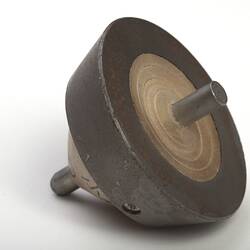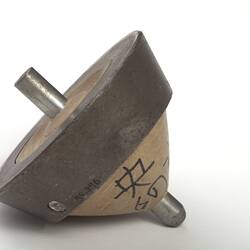Summary
Alternative Name(s): Fighting Top, Tetsudo, Iron-clad Top
Wooden and metal fighting top from Japan, donated by Mrs. Masumi Jackson in 1994. It is part of The Australian Children's Folklore Collection, which is unique in Australia, documenting contemporary children's folklore across Australia and in other countries reaching back to the 1870s. The Collection has a strong component of research material relating to Victoria.
Top-spinning is an ancient activity. Tops dated at 1200-1400BC were excavated in Egypt, and they are often mentioned in classical literature. They are found throughout the world and used by adults and children, in rituals as well as for games of skill. Japan, China and Korea have a long tradition of making and using tops. The toy has persisted in Japanese culture to the present day, and the variety of tops is astonishing. Some Japanese children, usually boys, are very skilled top-spinners. The variety of tops demonstrates the importance of this toy in Japanese culture. This heavy top is a 'fighting top', used to knock other tops out of the game. Iron-clad tops are only found in Asia, and demonstrate the principle of the flywheel, where greater weight on the perimeter allows the top to spin longer.
Physical Description
Heavy Japanese wooden and metal top. Top is natural wood, unpainted and unvarnished, with a thick metal band attached to the perimeter by two screws, and a metal spindle with a rounded point. Base of top is conical in shape, with Japanese script written in black ink.
More Information
-
Collection Names
-
Collecting Areas
Leisure, Home & Community, Childhood, Migration & Cultural Diversity
-
Acquisition Information
Cultural Gifts Donation from Dr June Factor, 18 May 1999
-
Acknowledgement
Donated through the Australian Government's Cultural Gifts Program.
-
Place & Date Made
-
Classification
-
Category
-
Discipline
-
Type of item
-
overall dimensions
6 cm (Length), 6 cm (Width), 6 cm (Height)
Height of top when standing upright on its point
-
Exhibition Collection Management
60 mm (Width), 60 mm (Height)
width indicates diameter
-
References
Gould, D.W.; The Top, Universal Toy, Enduring Pastime; Bailey Bros & Swinfen Ltd., Folkestone, England. 1975
-
Keywords
Cultural Traditions, Games, Japanese Toys, Metalworking, Toys, Woodworking, Making History - Australian Childrens Folklore





